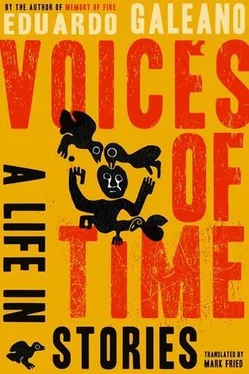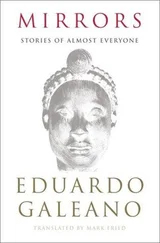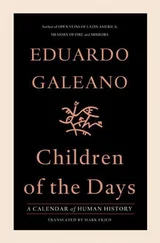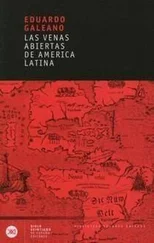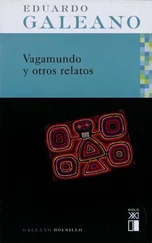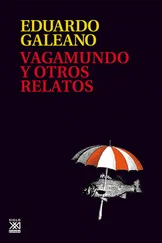In the streets of San Salvador, he continued talking to walls, and he punched them with his fists and hit them with his head because they would not answer.
He ended up in an asylum. There, they kept him tied to a bed. He no longer spoke, not even to the walls.
Norma, who years before had been his friend, went to see him. They untied him. She gave him an apple. Without a word, he gazed at the apple in his hands, that red and luminous world, and soon began slicing it with his teeth. Then he got up and handed out the pieces, bed by bed, to all the rest.
That’s how Norma learned: “Luis is crazy, but he’s still Luis.”
In the summer of 1972, Carlos Lenkersdorf heard this word for the first time.
He had been invited to an assembly of Tzetzal Indians in the town of Bachajón, and he did not understand a thing. He was unfamiliar with the language, and to him the heated discussion sounded like crazy rain.
The word tik came through the downpour. Everyone said it, repeated it— tik, tik, tik —and its pitter-patter rose above the torrent of voices. It was an assembly in the key of tik.
Carlos had been around, and he knew that in all languages / is the word used most often. Tik, the word that shines at the heart of the sayings and doings of these Mayan communities, means “we.”
In certain villages lost in the Andes, those with long memories recall the time the sky sat on the world.
The sky was so low that people went about stooped over and couldn’t straighten up without banging their heads. Birds would take off and crash into the roof at the first flap of their wings. The eagle and the condor charged with all their might, but the sky paid no heed.
The crush ended when a tiny dancing bolt of lightning flashed through the little air that remained. It was the hummingbird, and he stuck the sky’s behind with his needlelike beak. He kept stabbing away, obliging it to rise higher and higher until it reached the heights where it now stands.
The eagle and the condor symbolize strength and flight. But it was the smallest of the birds that liberated the earth from the weight of the sky.
The flea doesn’t flaunt. He doesn’t erect masts, towers, obelisks, or skyscrapers. Nor does he churn out rifles, cannons, or missiles.
The he-flea, lover of the she-flea, has no need for faux phalli. He’s got the real thing. It extends a full third of the length of his body, a size bested by none in the entire animal kingdom. And to top it off, it’s covered in down.
For thousands of years, the bullies and butchers of the human species have kept this humiliating fact secret.
The lion, emblem of bravery and nobility, invigorates anthems, dignifies flags, and stands guard over castles and cities. The hyena, symbol of cowardice and cruelty, neither invigorates nor dignifies nor guards anything. Leo the lion offers his name to kings and plebeians, but no one has ever been named Hyena.
The lion is a carnivorous mammal of the Feline family. The male specializes in roaring. His females hunt deer, zebras, and other defenseless or distracted beasts, while the male awaits his dinner. When the meal is ready, the male eats first. Whatever is left is for the females. Then, if anything at all remains, the cubs eat. If nothing is left, they do without.
The hyena, a carnivorous mammal of the Hyaenidae family, has other habits. He is a gentleman who brings the food and eats last, after the children and ladies have served themselves.
To praise, we say, “He’s a lion.” And to insult, “He’s a hyena.” The hyena laughs. I wonder why.
He got his bad reputation from Count Dracula.
Batman tried to improve his image, but the bat still arouses more terror than gratitude.
This symbol of the kingdom of darkness does not fly through the night in search of human necks. In real life, the bat does us the favor of fighting malaria by hunting a thousand mosquitoes an hour and is kind enough to help farmers by devouring harmful pests.
Despite our calumnies, this efficient pesticide does not give us cancer or charge so much as a cent for his services.
In movies and books, the cunning and bloodthirsty monster navigates the seven seas with jaws spread wide to reveal his teeth of a thousand knives. He dreams of us and licks his lips.
Outside movies and books, the shark fails to show the slightest interest in human flesh. Rarely does he attack us, and then only in self-defense or by mistake. When a nearsighted shark confuses one of us with a dolphin or a seal, he takes a bite and spits it out. We’re a lot of bones and not much meat, and our not-much-meat tastes awful.
We are the dangerous ones, and sharks know it. But sharks don’t make films or write novels.
The famous rooster of Moron was neither a herald nor a symbol of the new day.
He was, so they say, the judge or the tax collector or the king’s envoy. Gallo, meaning “rooster,” was his name, and he’d strut about town proclaiming, “Wherever this cock crows, everyone else shuts up.”
Adulator and humiliator, he licked up and spit down.
For years the silenced remained silent, until one fine day they attacked the ornate little town hall from which he perpetrated his abuse. They caught the malefactor, tore off his clothes, and chased him naked through the streets under a shower of stones.
This happened, so they say, some five centuries ago in the Spanish city of Morón de la Frontera, where visitors can still observe the defeathered fowl in full flight, sculpted in bronze. It’s a warning: tread carefully, you who are drunk with power or even a little tipsy; you too could end up plucked and squawking and driven from the city.

A look at the facts from Veterinarians Without Borders and from the U.S. Air Force shows that hens and warplanes don’t have much in common.
The hen looks like a hen and is called Hen, while a B-2A warplane looks like a bat and is called Spirit.
A hen costs at most five or six dollars, while each plane costs $2.2 billion.
A hen in good shape can cover half a mile, while the plane can fly 6,900 miles at twice the speed of sound without refueling.
The hen can’t fly much more than a hand’s breadth off the ground, while the plane flies at over thirty thousand feet.
The hen lays an egg a day, while the plane lays eighteen tons of satelliteguided bombs.
Sylvia Murninkas was rollerblading along Montevideo’s waterfront on a calm afternoon filled with light, when she heard the tumult of war.
The fighting was in the Hotel Rambla, which was undergoing renovations. The ground floor was filled with debris, and on top of the broken bricks and splintered wood lay a carpet of white feathers.
Sylvia backed away in fright. The symbols of peace were hacking each other to pieces with their beaks. They threw themselves at each other in sudden bursts, spun around in the air, crashed against the windows, then returned, bathed in blood, to the battle.
From afar, presidents and generals give the order to kill.
They won’t fight, except with their wives.
They won’t shed blood, except when they nick themselves shaving.
They won’t breathe poison gas, except for what cars spit out.
They won’t sink in the mud, no matter how much it rains in their backyards.
Читать дальше
